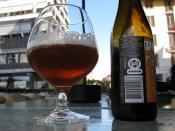Determination of Copper by Complexation, Solvent-Extraction and Spectrophotometry
Abstract
To determine the concentration of copper in an unknown solution by using copper complexation, solvent extraction and spectrophotometry. Standards are used to create a calibration curve and the unknown concentration of copper is then calculated by using the linear equation from the calibration curve. The concentration of copper in the unknown solution 201 was found to be 12.57ñ 0.25 üg/mL.
Introduction
Copper is an essential mineral in everyday life, it is in necessary for the production of red blood and it also keeps the immune systems, nervous system ad hones healthy.[7] Too much copper in a diet can possible health risks. There are several different ways to determine the concentration of copper in the unknown solution such as colourimetric titration, microwave digestions and spectrophotometry however using the solvent-extraction provides the most accurate measurements of solvent and using the spectrophotometry provides good accuracy at low concentrations of 10-6 g/m (ppm).
Theory
Solvent Extraction is the transfer of a solute from one phase to another. This process allows to isolate or concentrate the desired analyte or to separate it from species that would interfere in the analysis. The most used process is the extraction of an aqueous solution with an organic solvent. Diethylether, toluene, and hexane are common solvents that are immiscible with and less dense than water. They form a separate phase that ï¬Âoats on top of the aqueous phase. Chloroform and carbon tetrachloride are common solvents that are denser than water. In the two-phase mixture, one phase is mostly water and the other phase is mostly organic because they are immiscible liquids. Two liquids are miscible if they form a single phase when they are mixed in any ratio. However organic solvents with low polarity are generally immiscible with water. [2]...


